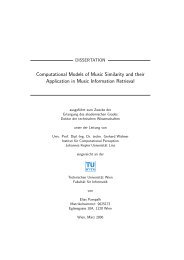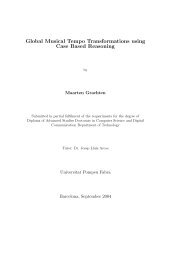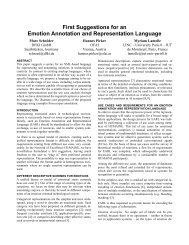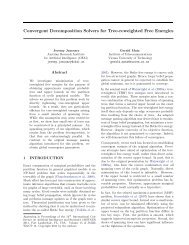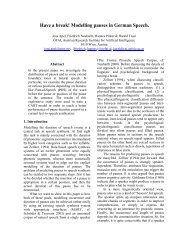A HYBRID MODEL OF REASONING BY ANALOGY
A HYBRID MODEL OF REASONING BY ANALOGY
A HYBRID MODEL OF REASONING BY ANALOGY
Create successful ePaper yourself
Turn your PDF publications into a flip-book with our unique Google optimized e-Paper software.
when the activation of some node exceeds a given threshold.<br />
The model presented in this chapter also uses the notion of spreading activation. The proposed<br />
variation is in some aspects closer to Anderson's ideas (it has an automatic nature) and in others to<br />
Holyoak and Thagard's work (the analogical mapping is triggered by the change of the focus, i.e.<br />
by the change of a node's activation). What is different from both approaches is that spreading<br />
activation is considered neither as an instantaneous operation before some matching processes<br />
start, nor as a side effect of the reasoning itself. Instead, this process runs continuously and in<br />
parallel to all other reasoning processes and thus influence their work reflecting the changing<br />
environment.<br />
7.2.2. Mapping<br />
The foremost problem with mapping, how to overcome the combinatorial explosion which will<br />
take place in case of an exhaustive comparison between all possible correspondences, is solved in<br />
various ways by various researchers.<br />
Gentner (1983), Falkenhainer et al. (1986) in their structure mapping theory (SMT) restrict<br />
possible element correspondences only to identical relations (attributes are discarded, objects are<br />
put in correspondence after the best mapping is found) and use a purely syntactic criterion for<br />
preference - the systematicity principle: it is the higher-order relational structure that determines<br />
which of two possible matches is made, preferring systems of predicates that contain higher-order<br />
relations (a syntactic expression of the tacit preference for coherence and inferential power in<br />
analogy). There are several problems with this approach. First, there are a lot of cases where<br />
different relations have to be put in correspondence (e.g. on(A, B) - support(B, A), on(A, B) - intouch(A,<br />
B), etc.). Second, object attributes are sometimes quite relevant (e.g. it is the attribute<br />
hot(plate) that causes the water to be heated). Third, this single criterion could be insufficient if, for<br />
example, two or more higher-order relations exist and the corresponding relational structures are<br />
equally systematic. Moreover, there are cases where the more systematic relational structure is less<br />
relevant and has to be ignored.<br />
Keane (1988) follows a radical pragmatic approach. According to what he proposes, the first stage<br />
of the reasoning process finds the critical object(s) of the target's goal (i.e. the object(s) whose<br />
manipulation or use is necessary to the achievement of the goal) and their functionally relevant<br />
attributes (FRAs). (The FRAs are those attributes which became salient in the context of a<br />
particular goal; one possible operationalization of this idea (Kedar-Cabelli, 1988) is the building of<br />
an explanation network.) Next, the reasoning process looks for an object with the same or similar<br />
FRA in the source domain and the relations which predicate this critical object in the source are<br />
mapped. Finally, other relations are mapped following the "cause" relations.<br />
This approach will also cause problems in several cases. First, as Gentner would say, this<br />
approach is restricted to problem solving where a clear goal exists. Second, it is not always<br />
possible to define a critical object and its FRA in the target situation before knowing the plan for<br />
achieving the goal; if, however, the plan is known, such an analogy would be used only for plan<br />
repairing. Third, in complex situations it would be necessary to use some kind of structural<br />
constraints in order to decide which of the relations predicating the critical object should be<br />
mapped.<br />
That is why I follow the approach proposed by Holyoak and Thagard (1989b) and use the<br />
structural, semantic, and pragmatic constraints together. However, the mechanism for mapping is<br />
extended significantly so that a constraint satisfaction machine similar to ACME will be only a part<br />
of the whole mapping process. The mechanisms for construction of the network are elaborated,




